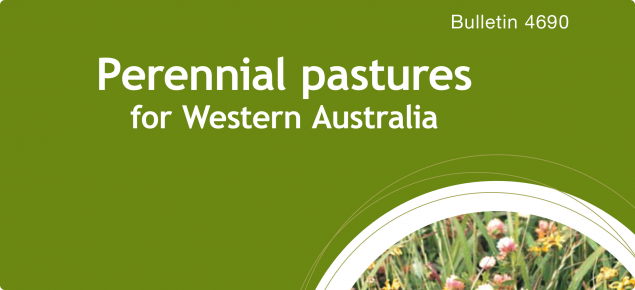Perennial pastures
There is a strong interest in perennial pastures due to the growing realisation that farming systems based solely on annual crops and pastures are not sustainable in many regions of south-western Australia. Environmental and management issues facing agriculture include: rising groundwater and the spread of salinity; herbicide resistant weeds; soil acidity and wind erosion. Perennial pastures offer a more sustainable and profitable alternative in many areas.
Potential production benefits from perennial species include:
- out-of-season green feed
- increased carrying capacity as a result of reducing summer/autumn feed gap
- reduced supplementary feeding particularly in autumn
- increased production from land with a previously low carrying capacity
- ability to turn-off animals outside the traditional growing season
- higher wool staple strength, reduced vegetable matter and increased wool production per hectare
- reduced reliance on fodder conservation
- opportunity to rest annual pasture paddocks after the break of the season allowing annuals to develop adequate leaf area to drive improved growth rates.
Soil conservation benefits include:
- increased water use and reduced deep drainage to groundwater
- reduction in the frequency of waterlogging
- maintenance of plant cover in summer leading to a reduction in soil erosion
- increased perennial cover for waterways.
Innovative producers have led the way in demonstrating that the large scale planting of perennial pastures is a viable alternative particularly when addressing deficits within their feed supply, for example, feed gaps. Some producers, particularly those in high rainfall, long growing season environments, are even close to achieving the goal of stock grazing green feed all year-round.
In some regions, perennial pastures are still a minor component of grazing systems, but in other areas have been widely adopted as a consequence of having profitable options for different parts of the landscape. By selecting species that are agronomically suited to the environment (soil, climate) and compatible with the farming enterprise, some of the least fertile and most fragile soils can be transformed into productive, sustainable areas with an increase in farm profit and reduced land degradation. Examples include:
- Alleys of tagasaste have transformed some of the poorest, deep-leached sands into productive paddocks. Tagasaste provides out-of-season green feed and increases carrying capacity, while also reducing wind erosion and deep drainage.
- Warm season grasses with companion annual legumes are turning waterlogged land that was previously over-run with reeds into some of the most productive and profitable pasture paddocks in the State.
- Phase farming with lucerne has created sustainable and profitable rotations with annual crops in medium and low rainfall environments.
- Alleys of saltbush are being used strategically to keep highly saline groundwater at depth, allowing productive non-halophytic pastures to be grown in the inter-row.
- Sub-tropical perennial grass based pastures are increasing productivity, while also reducing the risk of land degradation on large areas of sandy soils susceptible to wind erosion on the south coast and northern agricultural region.
Perennial pastures for Western Australia
The Perennial Pastures for Western Australia bulletin (Bulletin 4690) is a comprehensive, user friendly guide to selecting, growing and managing perennial pastures in WA. It covers all of the current and future perennial pasture options including: herbaceous perennial legumes, temperate grasses, sub-tropical grasses, herbs, native pastures, fodder shrubs and saltland pastures.
For each species there is a comprehensive description on current and potential use, establishment, soil and climate requirements and management. The bulletin also describes the perennial pasture options for each region and perennial pasture management (for example, grazing, animal production) in terms of the potential benefits and disadvantages (for example, animal toxicity, green bridge).
Bulletin contents
- Chapter 1 – Introduction
- Chapter 2 – Perennial pasture management
- Chapter 3 – Herbaceous perennial legumes
- Chapter 4 – Temperate perennial grasses
- Chapter 5 – Sub-tropical grasses
- Chapter 6 – Herbs
- Chapter 7 – Native perennial pastures
- Chapter 8 – Fodder shrubs
- Chapter 9 – Saltland pastures

